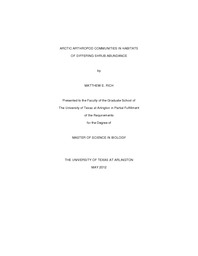| dc.description.abstract | Recent global warming, which has been severe in the Arctic, has caused advancement in the timing of snowmelt and expansion of shrubs into open tundra. Such an altered climate may directly and indirectly (via effects on vegetation) affect arctic arthropod populations. I conducted research at four sites in the vicinity of the Arctic Long Term Ecological Research (LTER) site at Toolik Field Station in northern Alaska in the summers of 2010 and 2011 to determine how vegetation and environmental variables affect arthropod abundance, diversity, and phenology (the timing of life history events) in habitats of differing shrub abundance. Shrub-dominated habitats in the Arctic have been shown to capture snow and delay the timing of snow melt, increase light attenuation through increases in canopy cover, and increase structural complexity compared with tundra with low or no shrub abundance. Arthropod abundance, diversity and community composition are known to be strongly influenced by the physical structure of the environment, and the phenology of arctic arthropods has been linked to the timing of snow melt. Consequently, I hypothesized that sites dominated by shrubs create a different habitat than open tundra vegetation and that this would alter arthropod community composition, patterns of abundance, and the phenology of arthropods. Shrub-dominated habitats were found to differ from open tundra habitats in several structural complexity measurements, having greater maximum shrub height, branch complexity, and foliar canopy cover during the period of maximum leaf out; this response was driven by two of the sites that had the tallest shrubs in the study. Additionally, snow melt was delayed in shrub-dominated habitats on average by 4 days, and a corresponding trend toward greater thawing degree days (TDD, more days above freezing) was found in open tundra habitat in 2011. Pitfall traps captured significantly more arthropods in shrub plots than open tundra plots, the most dramatic difference occurring in the most southern site. Furthermore, taxonomic richness and diversity were significantly greater in shrub plots than open tundra plots. Patterns of abundance within the five most abundant arthropod orders were found to differ, with spiders (Order: Araneae) more abundant in open tundra habitats and true bugs (Order: Hemiptera), flies (Order: Diptera), and wasps and bees (Order: Hymenoptera) more abundant in shrub-dominated habitats. Arthropod phenology was earlier in open tundra habitats, and phenological patterns differed among arthropod orders, most likely due to taxa-specific differences in timing of resources, opportunities for reproduction, and life history traits. Using a regression approach to assess variation across all the sites and vegetation types, few strong correlations were found between vegetation and environmental variables and the abundance and phenology of arthropods, although shrub height seemed to be important for the overall abundance of arthropods and the timing of snow melt and TDD were important for determining phenological patterns of arthropods. However, only certain orders showed significant correlations with the timing of snow melt and TDD, with earlier snow melt and higher TDD causing beetles (Order: Coleoptera) and Hymenoptera to reach their median activity level earlier in the season, respectively. As climate warming continues to increase over the coming decades, and with further shrub expansion and alteration in the timing of snow melt likely to occur, increases in arthropod abundance, richness, and diversity and a delay in arthropod phenology associated with shrub-dominated habitat may have important ecological effects in arctic food webs since arthropods are a major food source for migratory songbirds. Furthermore, climate change is going to impact arthropod taxa differently, modifying their contribution to arthropod-related ecological processes, including decomposition and trophic interactions, in which they play an important role in the Arctic. | en_US |


